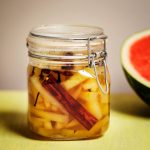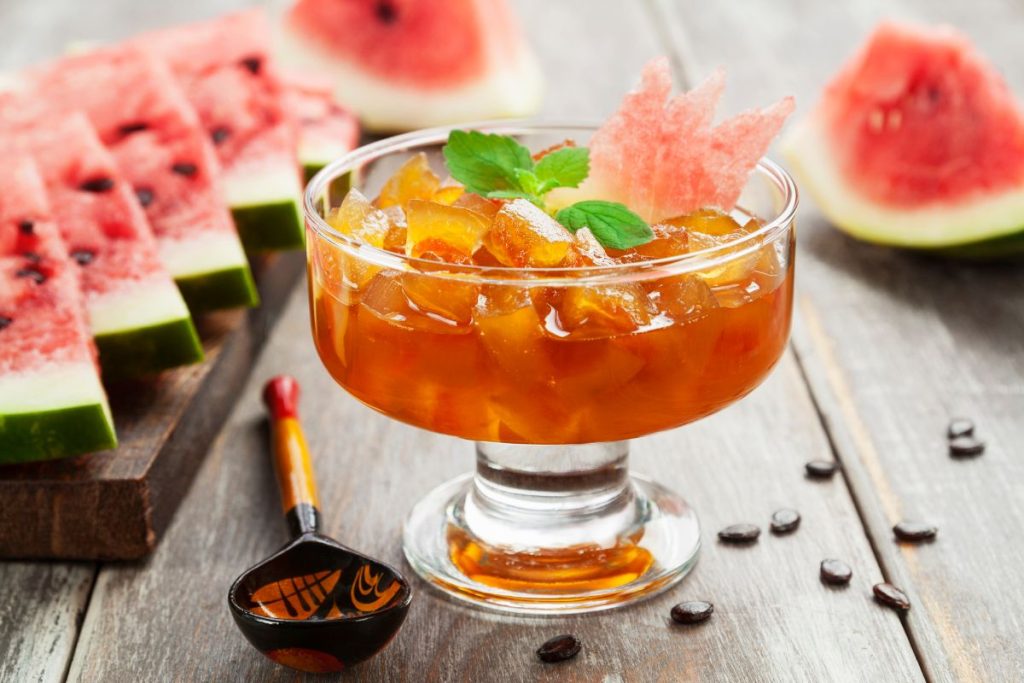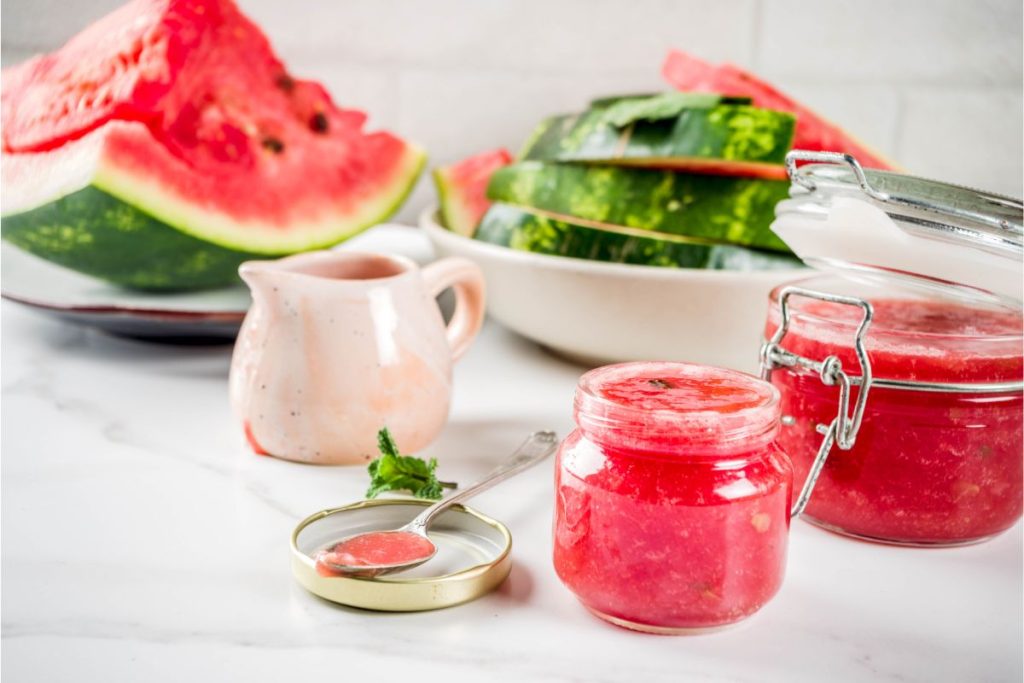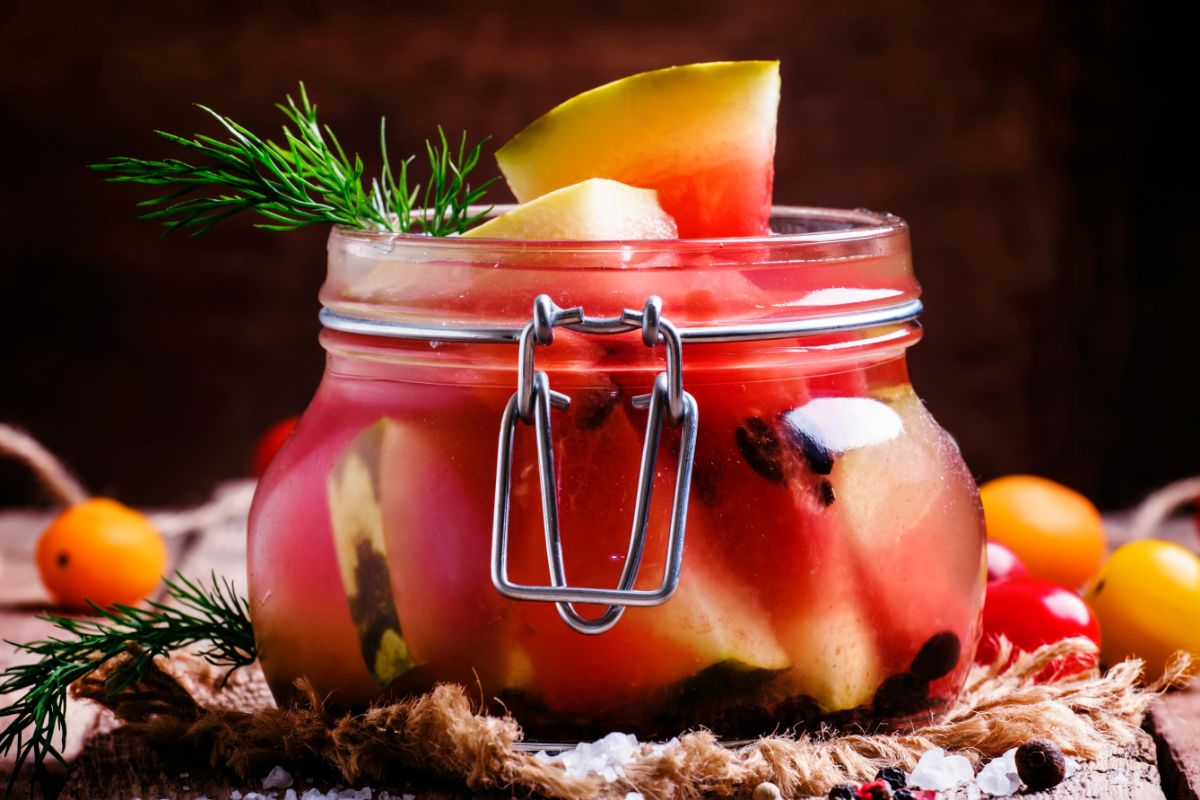The best way to preserve watermelon is to can watermelon jelly and pickled watermelon rind separately in a water bath canner. Cook pickled watermelon rind in simple syrup before ladling it in hot jars for processing. For the jelly, cook acidified watermelon juice in simple syrup and ladle it into hot jars for processing.
Should Watermelon Be Water Bath Canned or Pressure Canned?
The flesh of some mildly sweet watermelon species like cantaloupes is safely canned in a water bath canner with added acid ingredients or acids. According to the National Center for Home Food Preservation, you may can watermelon rind pickles and preserves in a boiling water bath canner.
Classic or regular pink- or red-flesh sweet watermelons aren’t suitable for canning because they are delicate, low-acid fruits. Watermelons are 92% water, and the high-pressure and canning temperatures would make them mushy and inedible.
Print
Home Canning Watermelon Pickles Recipe
- Total Time: 13 hours, 35 minutes
Description
Water bath canning watermelon pickles is easy, even if you are canning for the first time. Here’s a beginner-friendly canning recipe to try!
Ingredients
- 16 cups fresh watermelon rind cut into 1-inch pieces
- 16 cups water
- 1 cup canning salt
- 3 cinnamon sticks, 1-inch pieces
- 1 teaspoon whole cloves
- 2 cups white vinegar (5% acidity)
- 1 teaspoon whole allspice
- 3 cups white sugar
- 1 lemon, deseeded and thinly sliced
- 12 maraschino cherries, halved
Instructions
- Pick fresh watermelons with hard rinds and no broken skins or dark spots.
- Wash the melons under cool running water and scrub them with a vegetable brush to remove soil and debris.
- Cut the melons and scoop out the flesh to make canned watermelon jelly. Use a sharp, freshly cleaned knife to peel the outer green skin from the rind and trim the pink or red flesh. Cut the trimmed rind into 1-inch square cubes or long spears, depending on your preference.
- Make a brine with canning salt and water in a large pot. Stir until the salt dissolves. Add the watermelon rind pieces and cover the pot with a lid or plastic wrap. Let them sit for 12 hours to pickle. For faster results, add ice cubes after adding the rind and let sit for 3-4 hours.
- After the pickling time lapses, drain the rinds and rinse them in cold water.
- Combine 16 cups water and the drained, pickled watermelon rind in a large stock pot. Heat the contents to a boil. Adjust the heat to a medium-low simmer and cook the rind for 45-60 minutes until fork-tender. Drain and keep aside.
- As the rind cooks in the syrup, prepare your canning supplies. Wash six pint-sized jars and their canning lids and screw bands. Wash these in warm water with soap before rinsing them with warm water.
- Put the clean canning jars in a large pot, add fresh water, and heat them to a simmer. Let the jars remain hot until filled.
- Place a canning rack into your hot water bath canner and fill it halfway with fresh water. Heat the canner on medium-high heat and maintain it at a temperature of 180°F.
- Put half the cloves, allspice, and half the cinnamon sticks in a spice bag or cheesecloth. Combine the lemon slices, spice bag, white sugar, maraschino cherries, and vinegar in a large stock pot. Stir to dissolve all the sugar.
- Add the pickled watermelon to the stock pot and bring the contents to a boil. Adjust the heat to a medium-low simmer and cook for 5-10 until the rind turns transparent. Remove the spice bag.
- Put one cinnamon stick and one whole clove in each dried, hot canning jar.
- Ladle the hot acidified pickled watermelon rind and cooking liquid into the hot jars, leaving ½-inch headspace. Use a thin wooden stir stick inside the jars to remove air bubbles.
- Wipe the jar rims with moist paper towels. Top the jars with new lids and fasten the rings to fingertip tightness.
- Use a jar lifter to lower the jars into the canner without turning or tilting them. The tops of the jars should be 1-2 inches under the water.
- Raise the heat to high and heat the canner to a rolling boil. Place a lid on the canner and process the jars for 10-20 minutes, adjusting for elevation:
Water Bath Processing for Watermelon Rind Pickles
- 0 – 1,000ft: 10 minutes
- 1,001 – 6,000ft: 15 minutes
- Above 6,001ft: 20 minutes
Post Processing
- Take the canner off the heat, open the lid, and let the jars sit in the hot water for 5 minutes before removing the jars individually with canning tongs.
- Place the jars unturned and untilted on warm towels laid on a flat countertop. Let the jars cool undisturbed without re-tightening the lids for 12-24 hours.
- Take the ring bands off and check the seals for indentation and flexing. Save any jars with flexing lids in the refrigerator and consume the pickles within one month.
- Wash the exterior of all sealed jars and wipe them dry for labeling and storage in a cool, dry place.
- Prep Time: 12 hours, 15 minutes
- Canning Time: 10 minutes
- Cook Time: 1 hour, 10 minutes
Nutrition
- Serving Size: 1/4 pint
- Calories: 136kcal
- Sugar: 25g
- Sodium: 4624mg
- Fat: 1g
- Saturated Fat: 0g
- Carbohydrates: 34g
- Protein: 1g
What is the Best Way to Preserve Watermelon?
According to Oregon State University, the best way to preserve watermelons for the best flavor is to keep them whole and unwashed for 1-2 days or until ripe at room temperature. Once ripe and cut, watermelons should be stored in the refrigerator in airtight containers for 3-4 days at 35-40°F.
- Frozen watermelon is better for a longer shelf life of up to 12 months, but the chilling alters the flavor and texture.
- Freeze-dried watermelon lasts up to 12 months and maintains shape, flavor, and crispy texture.
- The best way to preserve watermelon rind is to flash-freeze it and then freeze it in airtight containers for up to six months.
- Unopened refrigerator pickled watermelon rinds (uncanned) last up to four weeks in airtight containers in the refrigerator.

How to Make Watermelon Jelly
Although watermelon flesh isn’t suitable for canning, it can be turned into an acidified jelly and processed in a water bath canner. Here’s a quick step-by-step guide for canning watermelon jelly:
- Use a potato masher to crush 6 cups of chopped, rind-free watermelon in a stainless steel pan. Cover with a lid and place over medium-low heat to cook for 5 minutes. Cut off the heat and crush the melons thoroughly.
- Use a blender or food processor to turn the cooked melon into juice. Strain this through a dampened and layered cheesecloth or jelly bag to remain with fine watermelon juice.
- Pour the juice into a deep stainless steel saucepan. Add 1/2 cup of vinegar, 5 cups sugar, 4 tablespoons of lemon juice, and one stem of fresh, chopped lemongrass and stir to combine.
- Heat the mixture over high heat while stirring constantly until it reaches a rolling boil. Add 6 ounces of liquid pectin and stir constantly as boiling continues for 1 minute.
- Use a jelly or candy thermometer to check the temperature of the cooking jelly. It should have an internal temperature of 220°F for proper setting. If this temperature is achieved, remove the jelly from the heat and skim off the foam quickly with a wooden utensil.
- Ladle the hot jelly into 5 hot half-pint jars. Allow ¼-inch headspace.
- Wipe the jar rims with dampened paper towels and apply the 2-piece canning lids, adjusting until the screw bands are finger-tight.
- Process the hot jars in a boiling water bath canner per the altitude-time adjustments below:
| Altitude (ft) | 0-1,000 | 1,001-3,000 | 3,001-6,000 | 6,001-8,000 | 8,001-10,000 |
| Processing | 10 mins | 15 mins | 20 mins | 25 mins | 30 mins |
- Once processed, remove the jars from the canner and let them cool for 12-24 hours, undisturbed. Check for proper sealing and keep washed and labeled sealed jars in a cool, dry, dark place.

What Are the Benefits of Canning Watermelon?
Canning watermelon ensures you enjoy the following benefits:
- Canned watermelon rind and jelly last longer than their fresh counterparts.
- Canning watermelon jelly eliminates the need to freeze the fruit, which alters its flavor and texture.
- Canning watermelon rind pickles reduces food waste since rinds are usually discarded.
- Pickled watermelon rind is a healthy, low-calorie snack.
- The lycopene in the rind may reduce the inflammation associated with arthritis.
- Watermelon rind is rich in citrulline, potassium, zinc, and vitamins A, B, and C.
How to Store Canned Watermelon
Store canned watermelon rind and jelly at room temperature in a cool, dry, dark location away from heat sources and direct sunlight. Store jars at least six inches off the ground to prevent metallic lids from corrosion.
What is the Shelf Life of Canned Watermelon?
Canned watermelon rind and jelly last up to 12 months at room temperature. For the best flavor, consume the products within six months.

